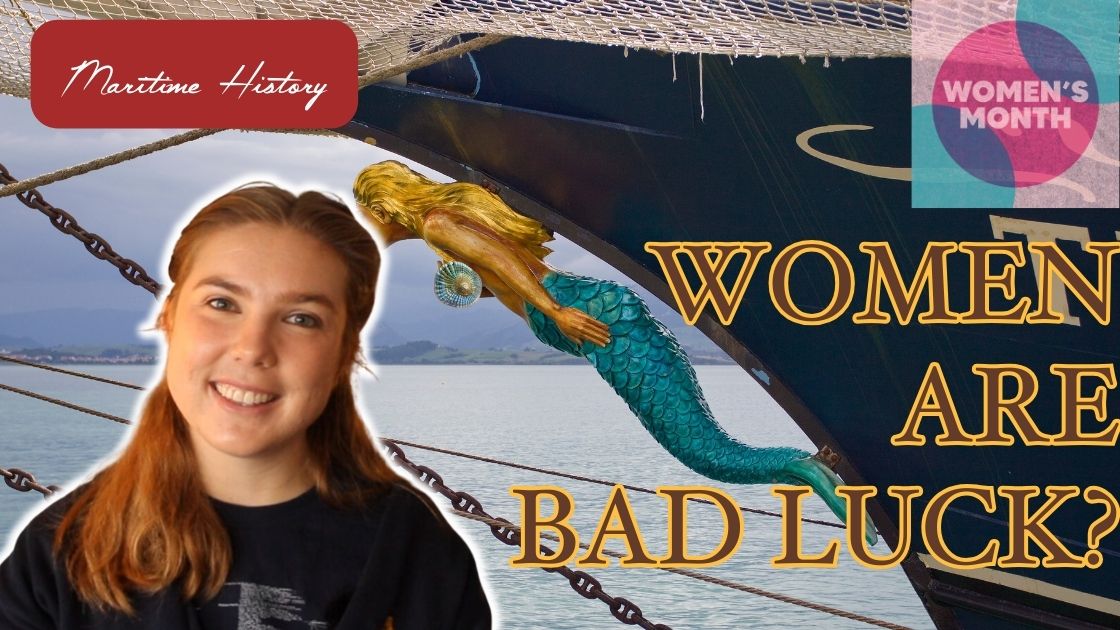
26 Mar Women on Ships in the 18th Century
For #TallShipTuesday this Women’s History Month, we learned about an old myth and how women could work on ships in the 18th century. Throughout history, it has been hard for women to carve out a space in the sailing world. The 18th century was especially hard because women were barred from working on and sometimes even boarding ships. Despite this women found a way onto ships and paving the way forward.
Superstition

In the 18th century, there was a myth that women were bad luck on ships. It is actually still a superstition women working on traditional ships may hear to this day. This myth may have originated from the idea that women could cause the crew to be distracted. This would then anger the sea herself, and the sea became treacherous in retaliation.
There may have even been some fears in europe that women who wished to work on ships were actually witches. Witches could manipulate the winds and seas. There is some folklore that refers to these ship-sinking witches. Some of these magicks were “the manipulation of thread, driving a knife into the ship’s mast to raise the wind, undoing knots tied on a piece of rope or a handkerchief [to call upon the wind], or by studying the behaviour of cats to determine the course of a storm.” These fears of the supernatural, irrational or not, used or not by ships captains and crew were another reason to bar women from these spaces
Figureheads

Now there were exceptions to this superstition. First, women as figureheads on the head of a ship. These “figureheads were often female but not exclusively so. A female may have been popular because the ship itself is always referred to as a ‘she’. As women were often not allowed on board, the figurehead itself might also represent the sole female on the ship.” Figureheads were mounted on the head of the ship (hence the name of that part of the ship). She would often have her gaze facing forward as to guide the ships through the waters and make her way safely to port. These figureheads did not originate with the myth, but thousands of years prior. The first evidence of figureheads date back to 3000 BCE in Egypt.
Women on board

Women in the 18th century were also reported to be allowed on ships if they were without clothes. This was thought to make the seas shameful and that in turn would make the sea suppress her vengeful nature, providing the ship safe passage. Sometimes the figureheads themselves would purportedly be bare for this purpose.
But women did find themselves on ships in more respectable ways as well. Wives and daughters of Captains or higher ranking crew were also commonly welcomed onto ships. They even learned about navigation and sailing while aboard, though unless in an emergency, were not called upon to participate in actions onboard the ship. The wife of Captain William Mayhew, a woman named Caroline Mayhew on the ship Powhaton “possessed a working knowledge of navigation and practical medicine. In 1846 when a small pox epidemic broke out aboard ship, she took over as captain in place of her stricken husband. She then ministered to him and the ailing crew, saving their lives.”
Notable Women on Ships

Some women did take to sailing, but to get there had to fight against the mold. In piracy, there was a little more freedom to be different, and we even saw female pirate captains in the 18th century. Anne Bonny or Mary Read sailed in the early to mid 1700s and did as much plundering as any other big name. Some women though may have cross dressed to be allowed on ships. Women like Hannah Snell dressed as a man in the royal navy for 4 years, to make a name for herself on the sea.
Luckily thanks to the actions of these women sailors and many more in the 18th century, over time it became more common and respectable for women to be on ships here in the US. While it took a while, by the 20th century, we started having more women breaking barriers and now in the 21st century, we have even more women making waves in the merchant service, the navy, racing and yachting, and here in the world of tall ships.
Further Reading
Debra Ronca, Why were women on ships considered bad luck?: https://people.howstuffworks.com/why-were-women-on-ships-considered-bad-luck.htm
New Zealand Maritime Museum, Top 20 Sailing Superstitions: https://www.maritimemuseum.co.nz/collections/top-20-sailing-superstitions
Western Maritime Institute, Superstitions at Sea: https://www.maritimeed.com/superstitions-at-sea/
Criostoir Mac Carthaigh, The Ship Sinking Witch: https://www.jstor.org/stable/20522410
Lizanne Henderson, Witch Belief in Scottish Coastal Communities: https://eprints.gla.ac.uk/152413/13/152413.pdf
Royal Museums Greenwich, Ship figureheads and decoration: https://www.rmg.co.uk/collections/ship-figureheads-decoration
National Parks Service, Women in Maritime History: https://www.nps.gov/safr/learn/historyculture/maritimewomenhistory.htm
Richard Pallardy, Anne Bonny (Britannica): https://www.britannica.com/biography/Anne-Bonny
Amy Tikkanen, Mary Read (Britannica): https://www.britannica.com/biography/Mary-Read
Yoriko Ishida, Hannah Snell: Cross-dressing Ideology in 18th-Century Naval Culture: https://think.iafor.org/hannah-snell-cross-dressing-ideology-in-18th-century-naval-culture/






Sorry, the comment form is closed at this time.